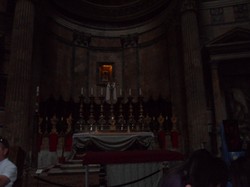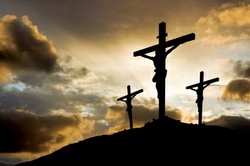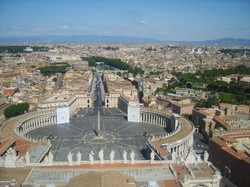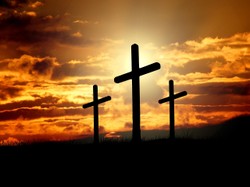There are four canonical gospels, only two of which have any birth narratives for Jesus. Mark begins with the start of Jesus' ministry, whereas John's prologue is metaphysical. Moreover, the two infancy stories are different from each other and are hard to make compatible, though there are no clear incompatibilities between them. There are questions about how much historical validity we can give them. Teasing out fact from myth and legend has proved a well nigh impossible task, but this is not unusual with ancient literature.

The Infancy Narratives: the story behind Christmas
by frankbeswick
There are two different infancy narratives in the gospels. How historically true theyr are is a matter of question, but they have a message.
Luke's Story
The story known and loved by many is that Mary and Joseph had to journey from their home in Nazareth to be registered in Bethlehem, Joseph's family home, as Augustus Caesar had declared a census of the whole Roman world. There they had no place to stay so they had to find a stable where the child was laid in a manger, and was later visited by shepherds, who had seen a vision of angels who announced the child's birth. In fact the stable is not mentioned in the canonical gospels, and it occurred in an apocryphal gospel written much after the original four. Most likely Jesus was born in a house. Palestinian houses of the time had two levels, a floor occupied by the animals, where there would be a trough/manger for the animals' food, and a slightly raised level where the family dwelt. Jesus was most likely born in Joseph's family home, but if it was crowded he may have been placed in the manger for comfort.
There are historical problems with this account, not just those raised by those who are routinely sceptical of everything, but genuine ones. Luke was a poor historian and his general chronology of events in his gospel leaves much to be desired, so this does not help his credibility, However, there is a possibility that Luke was not the author of the infancy chapters. The style of writing in the first four verses of the gospel changes and only restarts later in chapter 3. It is as though he took an existing document and included it, though some scholars are convinced that Luke wrote the whole gospel [that's not including those wonderful intellectuals who make a point of never believing that anyone wrote the books attributed to them!]
However, the problem is the census. Jesus was probably born 6 BC [the monk who calculated his birth year got it wrong]. Herod the Great, in whose reign Jesus was born, died in 4 BC. Yet Augustus did order a census in seven AD. The events are out of kilter and it is likely that if there was any census at all it was a purely local registration at an earlier time than the main one.
Some scholars argue that Jesus was not born at Bethlehem. They argue that the family came from Nazareth, so why go to Bethlehem to be registered, which Rome did not demand? There was also a Bethlehem in Galilee, and some think that Jesus was born there, though no one in Galilee ever made the claim for that Bethlehem in ancient times. However, the case for Bethlehem is often overlooked. Joseph belonged to the family of David, whose family lands were at Bethlehem in Judea. In a time when families lived together he would have wanted to take Mary to the family home in Bethlehem. What then was he doing in Galilee? Easy, he was a tecton [carpenter, builder.] Builders have to go where the work is, and there were plenty of building works in Galilee, all instituted by the construction-mad Herod. Joseph was a migrant builder following the money. In Galilee he met Mary, and the rest is history. But he would have wanted to go home sometime and take her with him. Interestingly, no one in ancient times challenged the story of Jesus' birth at Bethlehem.
Holy Land
 | Bethlehem Explores the hidden meanings of Our Lord's Incarnation, birth, infancy and early life and expands his theme to a wide-ranging discourse on the entire Catholic Faith from the poi... |
Matthew
Matthew's gospel takes a different slant, working from Joseph's angle. Here we find the story of his puzzlement with Mary's pregnancy, and his decision to informally divorce her, only to be informed by an angel that the child was from God, whereupon Joseph immediately took her to his home. In ancient times you became married,after betrothal, when the man took the woman into his home as his wife.
The story of the Magi is contained only in Matthew's gospel. They were identified as magi, Persian holy men. The Bible nowhere says that they were three or gives their names. Calling them three kings is mediaeval nonsense with no substantiation. The Bible story is that they see a star in the East and realize that it is a sign of a great king being born in Israel, so they follow the star and reach the court of Herod the Great, a tyrant who fears that the child will overthrow his dynasty. So he asks the wise men to seek the child and when they go home by another route he launches a massacre of children in Bethlehem to eliminate the child, but Joseph had been warned by an angel to flee, so Jesus is safe. He then spent some time in Egypt, but when Herod died and his psychopathic son Herod Archelaus took over Judea, Joseph decided to settle in Galilee, which was to be run by Herod Antipas, who was not as nasty as his elder brother. This explains why Jesus was not living close to his relatives.
The wise men themselves are thought to be legendary, However, the fact that they could escape without Herod being able to do anything about it does suggest something that may indicate some truth behind the tale. As magi they were under the protection of the Parthian king [emperor of the Persian empire], and the Parthians were warlike and sensitive to insults, so any harm to their magi would have led to war, and Augustus Caesar would not have thanked Herod for bringing down thousands of enraged, battle hardened Parthians across his borders. Herod would have had to grit his teeth and let them have their way. He could take revenge on anyone who dealt with them later.
People talk about the star of Bethlehem, and it is the case that stellar portents were often claimed to have occurred at the birth of great men. The star is primarily mythical, but there was a peculiar astronomical event that happened about six BC. Three planets, Jupiter, the planet of kingship, Mars, the planet of war, and Saturn, which signified Israel came into conjunction thrice within a year. To the ancients this would have signifiied the coming of a king of Israel, and there could well have been magi coming to find out more. This event could well have given rise to the story and there could well be something in the tale of the wise men, though the story was cast in mythological form by the gospel writers.
Scholars to think that the story of Herod and the child is a legend, and it follows a common mythological theme, the true heir to a throne being persecuted by a usurper, but escaping. There is no historical corroboration of the massacre of the innocents, but it was well within Herod's character. Two years later when he was dying he ordered leading men from Judea rounded up and gave the order that when he died they were to be killed. His reason: they won't mourn me, but at least they will mourn. Nice chap! The order, though, was not carried out.
Bethlehem
 | The Star of Bethlehem Updated DVD with new Features: From Producer Stephen McEveety (The Passion of the Christ) comes an amazing documentary on the Star of Bethlehem. This presentation, has rapidly g... |
Myth, History or Legend
Are the infancy stories historically true? By this do we mean they are factually accurate to the exact detail. Probably not. The shepherds are almost certainly legendary, representatives of the poor for whom Christ came. But can we claim that they are totally fictitious? This is as unlikely as the claim that they are totally true.Between the Scylla of total fictitiousness and the Charybdis of the total accuracy there lies the truth, subtler, harder to discern and less attractive to simple minds overconfident of their wisdom than the two extreme alternatives. I think that some bits may be historically true, but which ones cannot be known with certainty.
The issue is the relationship between myth and history. Are the two mutually exclusive? If they are, then myth and life are divorced, whereas myth speaks of the great truths of life, so they must be linked. Clearly, there is a mythical pattern in the story of Herod's attempt to kill the child, but whether it is historically true or not the mythical structure would be the same. One great mistake made by scholars is to think that if there is a literary pattern to be found in a story it must be fictitious. But literature and life have much in common, for literature speaks of life.
The events of Christ's life can be viewed through the lens of myth, but they can be seen under different lenses and on different levels. The whole story of Christ is replete in mythical themes, but there is historical truth in it. Ultimately the Christmas story has enormous power to sway, and its appeal to the heart has endured over two millenia, whatever the truth or otherwise of the historical claims. Myth speaks great truths to the heart and soul.
You might also like
Who was JesusTo understand Jesus you must realize that he was a mystery that theology trie...
Ministry in the church:women bishopsThe long awaited decision to have women bishops is major progress.
Women of the GospelsWomen played an important role in Jesus' ministry, but they have often been n...



 TheThousand Year Gardenon 11/26/2025
TheThousand Year Gardenon 11/26/2025
 Women of the Gospelson 10/11/2025
Women of the Gospelson 10/11/2025
 Religious Gardenson 08/25/2025
Religious Gardenson 08/25/2025
 Doctor of the Church: John Henry Newmanon 08/03/2025
Doctor of the Church: John Henry Newmanon 08/03/2025




Comments
The apparition has not been accepted by the church.
Thank you for your comment below in answer to my previous observation and question.
Some online sources associate Saint Paul with witnesses to Jesus Christ's crucifixion. They consider Saint Paul as for Jesus Christ's death and against Our Lady Mary's sorrow.
Some such sources bring up as their source Mary of Jesus of Ágreda (Apr 2, 1602-May 24, 1665), her apparitions and her book The Mystical City of God.
Does Mary of Jesus of Ágreda serve as a source to be considered about Our Lady Mary's attachments and sorrows, deeds, friendships and thoughts?
No. There is no evidence that Paul met Mary.
Thank you for your comment below in answer to my previous observation and question.
Some online sources appear to associate in-person meetings more between Our Lady Mary and Saint Paul than between Our Lady Mary and Saint Luke.
Is there any source or any tradition about such an interaction between Our Lady Mary and Saint Paul?
Itnis from his own letters that we known that henunderwent some illness.
Thank you for your comment below in answer to my previous observation and question.
Saint Paul with a chronic illness intrigues me. Is that illness known from a Biblical book or from Christian tradition or from some other source?
There is a tradition that Luke was a healer. He went with Paul, and it is known that Paul suffered a chronic illness, though we do not know what it was.
Thank you for your comment below in answer to my previous observation and question.
Some online sources associate Saint Luke with medical practice and skills because of the passage "Physician, heal thyself" within his gospel.
Would Saint Luke have been doctor or shaman or both?
We do not know whether Luke and Mary ever met, but she was prominent in the church and so if they went to Christian gatherings someone would have pointed out Mary to Luke.
Thank you for your comment below on Mar 1, 2023, in answer to my previous-day observation and question.
It's so compelling to imagine Saint Luke meeting one of his heroes and heroines in Our Lady Mary.
Is it possible that not just the Ephesus meeting, but no meeting anywhere, ever took place between the two?